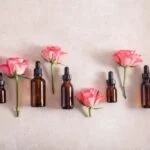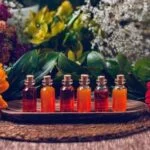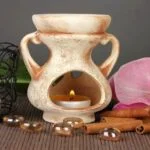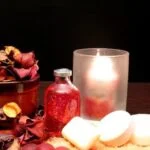Aromatherapy has become increasingly popular in recent years, with individuals turning to the therapeutic power of essential oils and aromatic plants to promote health and well-being. But where did aromatherapy start? In this article, we will delve into the rich history of aromatherapy, tracing its roots back to ancient civilizations and exploring how it has evolved into a mainstream healing practice today.
The origins of aromatherapy can be traced back thousands of years, when various cultures began harnessing the power of aromatic plants for medicinal and spiritual purposes. From Ancient Egypt’s sacred fragrances to Greece’s use of plant extracts for healing, aromatic therapies have played a significant role in our ancestors’ lives. Understanding this historical context helps us appreciate the tremendous impact these natural remedies have had throughout human history.
By understanding the foundations upon which modern aromatherapy is built, we gain insight into the cultural significance and ancient wisdom that underpins this holistic practice. Join us as we take a journey through time, uncovering fascinating stories and traditions surrounding aromatic plants and their therapeutic properties. Discover how ancient civilizations paved the way for modern aromatherapy techniques that continue to benefit individuals seeking balance, relaxation, and rejuvenation in today’s fast-paced world.
Ancient Healing Traditions
Exploring Ancient Civilizations
Ancient civilizations such as Egypt, Greece, and China played a vital role in laying the foundation for aromatherapy as we know it today. These cultures recognized the therapeutic properties of aromatic plants and utilized them for healing purposes. In Egypt, aromatics were deeply intertwined with religious ceremonies and embalming practices. The Greeks and Romans integrated aromatic medicine into their healthcare systems, while Traditional Chinese Medicine harnessed the power of aromatics to balance the body’s energy flow.
Egypt: Sacred Fragrances and Rituals
The use of aromatic oils, herbs, and resins in ancient Egyptian society was extensive. Aromatics held great significance in religious rituals, where specific scents were believed to connect humans with divine beings. Furthermore, they were widely used during the mummification process as well. Egyptians used various botanical extracts to create perfumes, incense, and medicinal ointments. They believed that these fragrances had profound effects on both the physical body and the soul.
Greece and Rome: Plant Extracts for Health
Ancient Greek physicians like Hippocrates recognized the therapeutic benefits of aromatics and incorporated them into medicinal treatments. This early use of plant extracts for health contributed significantly to the field of aromatherapy. In Roman culture, baths were an essential part of daily life, with bathhouses incorporating aromatic oils for relaxation and healing purposes. The Romans understood the physiological effects scents can have on individuals and utilized them accordingly.
These ancient healing traditions laid a strong foundation for what is now considered modern aromatherapy. By exploring these historical practices and understanding their significance, we gain valuable insight into the origins of this holistic approach to well-being.
The Birth of Modern Aromatherapy
Ren-Maurice Gattefoss, a French chemist, played a pivotal role in the birth of modern aromatherapy. It was his accidental discovery and subsequent research that led to the recognition and establishment of aromatherapy as a distinct form of healing.
Gattefoss’s journey into the world of essential oils began in the early 20th century when he experienced a significant burn accident in his laboratory. This incident sparked his curiosity about the therapeutic properties of certain plant essences, which ultimately led to groundbreaking revelations.
In 1910, Gattefoss had an accident while working in his laboratory when he severely burned his hand. Acting on instinct, he immediately plunged his hand into a nearby container filled with pure lavender essential oil instead of water, expecting it to extinguish the flames. To his surprise, not only did Gattefoss experience immediate pain relief, but also witnessed rapid healing and minimal scarring. Intrigued by this extraordinary event, he dedicated himself to studying the potential medicinal benefits of essential oils.
Gattefoss’s extensive research on essential oils and their healing properties eventually led him to develop the term “aromatherapy” in 1937. He published a book titled “Aromathérapie: Les Huiles Essentielles Hormones Végétales” where he outlined various uses for essential oils and coined the term that is now widely recognized today. Gattefoss’s work significantly contributed to establishing aromatherapy as a legitimate field of alternative medicine worldwide.
Aromatherapy Through History: Ancient Egypt’s Sacred Fragrances
Ancient Egypt holds great significance in the history of aromatherapy due to its extensive use of aromatic oils, herbs, and resins for sacred rituals and embalming practices.
In Egyptian culture, fragrances were considered sacred and were believed to have divine properties that could purify the body and soul. The Egyptians made extensive use of essential oils, primarily through incense burned during religious ceremonies and in cosmetic preparations.
One of the most famous examples of aromatherapy in ancient Egypt is the use of kyphi, a complex mixture of various aromatic ingredients including myrrh, frankincense, cinnamon, juniper, and more. Kyphi was used in religious ceremonies to invoke deities and bring about spiritual purification.
Beyond religious rituals, aromatherapy also played a crucial role in embalming practices. Various essential oils and aromatic substances were used to preserve bodies during mummification, ensuring that the deceased would have an enjoyable afterlife.
The significance of specific scents cannot be understated in ancient Egypt. For example, myrrh was believed to have rejuvenating properties for both the body and mind. Frankincense was associated with spirituality and used to enhance meditation and prayer practices.
The use of aromatherapy in ancient Egypt highlights the historical recognition of fragrances as a powerful tool for physical, mental, and spiritual well-being – a concept that has persisted throughout history until today.
Aromatherapy in Ancient Egypt
Ancient Egypt holds a prominent place in the history of aromatherapy, as the civilization not only extensively used aromatic oils but also incorporated them into their religious ceremonies and embalming practices. The ancient Egyptians revered scents for their powerful effects on the mind, body, and soul. Aromatic oils, herbs, and resins were considered sacred and played a crucial role in various rituals.
One of the significant aspects of aromatherapy in ancient Egypt was its use in religious ceremonies. Fragrant oils were believed to have a spiritual connection and were used to honor gods and goddesses. Temples were filled with the sweet aroma of incense, which was thought to purify the air and create a sacred atmosphere. Different scents corresponded to different deities, with each god or goddess having their associated fragrance.
The ancient Egyptians also utilized aromatic oils in embalming practices. They believed that these oils had preservative properties that would help preserve the bodies of the deceased for eternity. Essential oils such as cedarwood, frankincense, myrrh, and rosemary were carefully selected for their cleansing and purifying qualities. These aromatic substances were used during the mummification process to ensure proper preservation while also providing a pleasing fragrance.
Aromatic Medicine in Ancient Greece and Rome
In ancient Greece and Rome, the use of plants for medicinal purposes was widely practiced. Greek physicians like Hippocrates made significant contributions to the development of aromatherapy by utilizing aromatic plants and oils in their medicinal treatments. Similarly, in Rome, aromatic oils were incorporated into various aspects of daily life, including the popular Roman bathhouses.
Greek physicians recognized and leveraged the therapeutic properties of aromatic plants to promote health and well-being. Hippocrates, often referred to as the “Father of Medicine,” used essential oils extracted from plants such as lavender, thyme, and chamomile in his treatments. These oils were applied topically or ingested as remedies for a wide range of ailments, including digestive issues, respiratory problems, and insomnia.
Roman civilization embraced the use of aromatic oils not only in medicine but also as a part of their luxurious lifestyles. Aromatic baths became an integral part of Roman bathhouse rituals. The Romans believed that these fragrant baths helped to cleanse and detoxify the body while also promoting relaxation and overall well-being. They would add essential oils such as rosemary, rose, lemon balm, or frankincense to their bathwater to enhance their bathing experience.
The practice of using plant extracts for health in ancient Greece and Rome laid the foundation for modern aromatherapy practices. These ancient civilizations understood and valued the therapeutic effects of essential oils and other aromatic substances. Today, we continue to recognize their contributions by incorporating these plant extracts into various aspects of our lives for holistic healing purposes.
Traditional Chinese Medicine
In the realm of ancient healing traditions, Traditional Chinese Medicine (TCM) stands out as a rich and profound system that incorporates the use of aromatics for therapeutic purposes. TCM has been practiced for thousands of years and encompasses various modalities, including acupuncture, herbal medicine, and qi gong. Aromatherapy plays a significant role within this holistic approach to well-being.
The Integration of Aromatic Herbs
In TCM, aromatic herbs are an integral part of treatment protocols due to their believed ability to influence energy flow (qi) within the body. These herbs are often categorized based on their flavor and properties, such as warm, cool, hot, or cold. For example, warming herbs like ginger or cinnamon promote circulation and can be used to alleviate symptoms related to coldness or stagnation in the body.
Additionally, aromatic essential oils are often used in TCM for external application or inhaled for their therapeutic effects. These oils can be derived from a wide range of plant sources such as lavender, jasmine, or peppermint. Each oil has its own unique combination of properties and is selected based on individual needs and imbalances identified by a TCM practitioner.
Harmonizing Energy Flow with Meridians
Central to TCM theory is the concept of meridians – energy pathways that run throughout the body. It is believed that imbalances in these meridians can lead to physical or emotional ailments. Aromatherapy is utilized in TCM to help rebalance these energy pathways and restore harmony within the body.
For example, if someone is experiencing anxiety or insomnia, a TCM practitioner may use calming essential oils like chamomile or bergamot to soothe the mind and balance the heart meridian. On the other hand, if someone has digestive issues like bloating or nausea, essential oils with a warming quality like ginger or cardamom may be used to stimulate the digestive meridians and promote healthy digestion.
Through the integration of aromatic herbs, essential oils, and meridian-based therapies, TCM harnesses the power of aromatics to restore balance and enhance overall well-being.
The Contemporary Application of Aromatherapy in TCM
As the popularity of aromatherapy continues to grow worldwide, more and more people are seeking out TCM practitioners who incorporate these therapeutic techniques. Today, there are specific clinical practices within TCM that focus solely on aroma-acupuncture or topical application of essential oils for various health concerns.
Furthermore, research studies are being conducted to explore the efficacy of different aromatic interventions within the field of TCM. Some studies have shown positive results in using essential oils for pain management, stress reduction, or improved sleep quality. These findings contribute to the ongoing development and refinement of aromatherapy practices within Traditional Chinese Medicine.
Aromatherapy in Modern Times
Aromatherapy has experienced a significant shift in perception and acceptance over the years, transitioning from being considered an alternative therapy to becoming a mainstream practice in modern times. This section will explore the increasing popularity of aromatherapy and its integration into contemporary medicine and healthcare practices.
In recent decades, there has been a growing interest in holistic approaches to health and wellness. Aromatherapy, with its natural healing properties and focus on the mind-body connection, resonates with individuals seeking alternative treatments that complement conventional medicine. The use of essential oils and aromatic compounds derived from plants is regarded as a safe and effective way to promote relaxation, reduce stress, alleviate pain, improve sleep quality, enhance mood, and boost overall well-being.
The widespread adoption of aromatherapy can be attributed to several factors. First, there has been a wealth of scientific research supporting the therapeutic benefits of essential oils. Studies have shown that certain essential oils possess antimicrobial, antioxidant, anti-inflammatory, analgesic, and mood-enhancing properties. This evidence-based approach has contributed to the credibility of aromatherapy as a valid form of treatment.
Moreover, the accessibility of essential oils and related products has greatly increased in recent years. Aromatherapy is no longer limited to specialized clinics or practitioners; it can now be easily incorporated into daily life through home diffusers, personal inhalers, bath salts, massage oils, skincare products, candles, and more. This accessibility has allowed individuals to experience the benefits of aromatherapy firsthand and integrate it into their self-care routines.
| Aromatherapy Usage | Percentage |
|---|---|
| For relaxation purposes | 67% |
| For stress reduction | 61% |
| For improving sleep quality | 53% |
| For mood enhancement | 45% |
According to a survey conducted by the National Center for Complementary and Integrative Health, around 67% of individuals use aromatherapy for relaxation purposes, while 61% use it as a means of reducing stress. Additionally, over half of the participants reported using aromatherapy to improve sleep quality (53%) and enhance their mood (45%). These statistics reflect the widespread appeal and utilization of aromatherapy in modern times.
Current Innovations and Future Trends in Aromatherapy
Aromatherapy, with its rich historical roots, continues to evolve and adapt to the needs of modern individuals. In recent years, there have been noteworthy innovations and emerging trends in the field that demonstrate the ongoing growth and potential of aromatherapy as a complementary therapy.
One notable innovation in aromatherapy is the development of new techniques and application methods for essential oils. Traditionally, essential oils were applied topically or diffused into the air, but now there are alternative ways to experience the benefits of aromatherapy. For example, some individuals are exploring inhalation methods such as using personal inhalers or taking aromatic steam showers to maximize the therapeutic effects of essential oils.
In addition to new application methods, the industry has seen advancements in product development. Aromatherapy companies are now creating more convenient and user-friendly products to enhance people’s experiences with essential oils. This includes pre-diluted roll-on blends for easy topical application, portable diffusers for on-the-go use, and even wearable diffusing jewelry that allows individuals to enjoy the benefits of aromatherapy throughout their day.
Looking towards future trends in aromatherapy, one area of focus is the integration of technology. As technology continues to advance, there is great potential for incorporating virtual reality (VR) and augmented reality (AR) into aromatherapy practices. Imagine being able to immerse oneself in a virtual environment while simultaneously experiencing corresponding scents through specialized devices or diffusers. This fusion of technology and aromatherapy has the potential to provide even deeper relaxation experiences or facilitate emotional healing by creating immersive multisensory environments.
Furthermore, research in neuroscience and psychophysiology is shedding light on how specific scent combinations can affect brain activity and emotional states. As our understanding of scent perception advances, we can expect more personalized approaches to aromatherapy based on individual preferences and desired outcomes. This could involve the development of scent profiling tools that match individuals with specific essential oil blends tailored to their unique needs.
Conclusion
In conclusion, the exploration of the origins of aromatherapy reveals its deep historical roots and its ongoing relevance in contemporary society. Ancient civilizations such as Egypt, Greece, and China laid the groundwork for the development of aromatherapy, using aromatic plants for healing purposes and recognizing the therapeutic properties of essential oils. It was Ren-Maurice Gattefoss’s accidental discovery and subsequent research that led to the birth of modern aromatherapy.
These ancient cultures recognized the power of aromatics in promoting physical, mental, and emotional well-being. In Ancient Egypt, aromatic oils were used in religious ceremonies and embalming practices, while Greek physicians like Hippocrates utilized aromatics in medicinal treatments. The integration of aromatic herbs and oils into Traditional Chinese Medicine showcased their believed ability to balance the body’s energy flow.
Aromatherapy has not only persisted throughout history but has also gained popularity in recent decades due to its holistic approach and natural healing properties. Its integration into contemporary medicine and healthcare practices further solidify its significance today. As new techniques, products, and research continue to emerge in the field of aromatherapy, it is evident that this ancient practice is evolving to meet the needs of modern individuals who seek alternative and holistic approaches to wellness.
Overall, reflecting on the historical and contemporary significance of aromatherapy reminds us that it is more than just a pleasant fragrance or a relaxing experience. It represents a rich heritage of ancient knowledge combined with innovative ideas for overall well-being. By understanding where aromatherapy started and how it has evolved over time, we can appreciate its ongoing role in promoting balance and enhancing our physical, mental, and emotional health in today’s fast-paced world.
Frequently Asked Questions
When was aromatherapy first invented?
Aromatherapy, as a holistic healing practice, was not invented in a specific moment or by any particular person. Instead, it has evolved gradually over thousands of years and across various cultures. The use of aromatic plants and their essential oils for therapeutic purposes can be traced back to ancient civilizations such as the Egyptians, who utilized fragrant substances in religious rituals and for embalming purposes.
The origins of aromatherapy can also be found in traditional Chinese medicine and Ayurveda, an ancient healing system from India. While the precise time of its inception is unclear, the wisdom behind the benefits of aroma on physical and mental well-being has been passed down through generations.
What is the history and background of aromatherapy?
Aromatherapy has a rich history that spans centuries. In ancient Egypt, aromatic substances were highly regarded and had both cosmetic and medicinal uses. The Greeks also embraced aromatherapy, with famous figures like Hippocrates using essential oils for their therapeutic properties.
During the 19th century, modern aromatherapy began to take shape with the development of distillation techniques to extract essential oils from plants. French chemist René-Maurice Gattefossé coined the term “aromatherapy” in 1928 after an accident where he discovered lavender oil’s remarkable wound-healing properties. This sparked further scientific research into essential oils’ therapeutic effects, leading to its integration into modern medicine and alternative healing practices.
When did aromatherapy come to the US?
Aromatherapy arrived in the United States during the 20th century but gained significant popularity later on. In the 1960s and 1970s, with the rise of alternative medicine movements and counterculture, interest in holistic healing methods including aromatherapy surged across America. The New Age movement in particular embraced aromatherapy as part of its focus on natural remedies and personal well-being practices.
Through this renewed interest, information on aromatherapy spread rapidly through books, workshops, and the growing availability of essential oils. Today, aromatherapy has become widely embraced in the United States, with its therapeutic applications recognized both within complementary and mainstream healthcare settings.

Are you looking for a natural way to improve your health and wellbeing?
If so, aromatherapy may be the answer for you.





